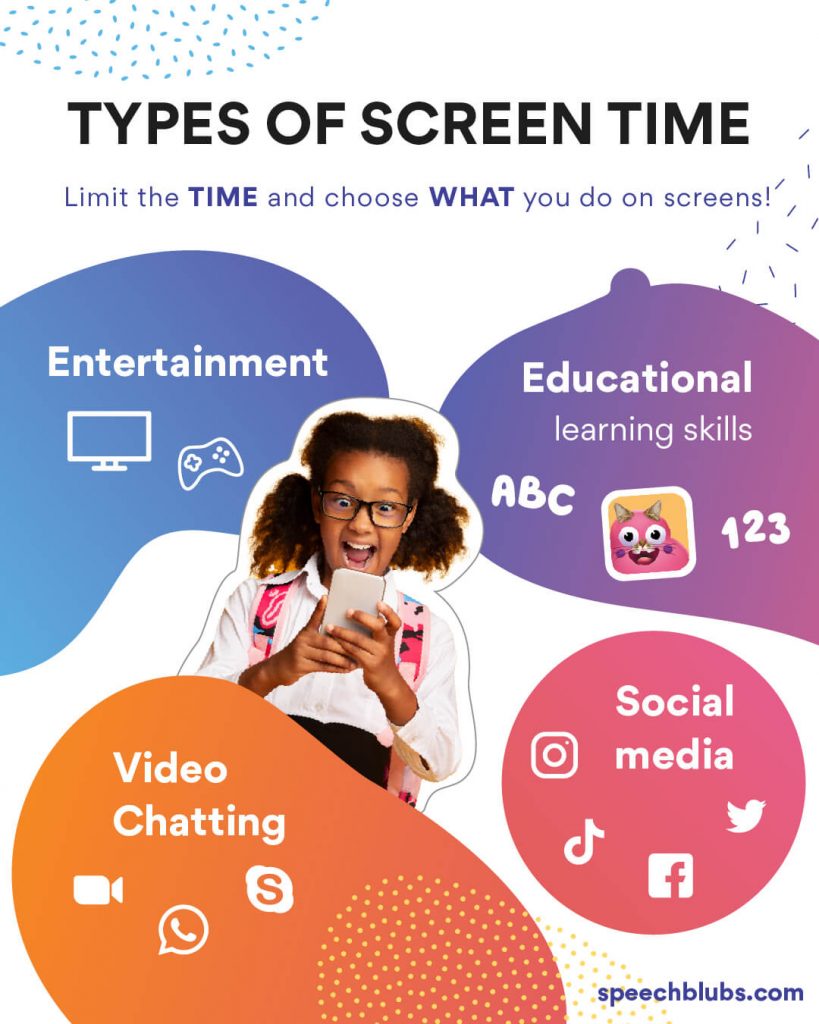Screen Time: An All-in-One Guide
Feb 6, 2022 Whether and how much parents should allow children to use smart screens is a hotly contested and evolving controversy. The recommendations by ASHA, the AAP, and the WHO have all changed recently.
Welcome to our series of “All-in-One” guides connecting blog writers around an important topic that is explored in-depth on our blog page. The subject of this guide explores whether screen time is beneficial for toddlers.
In This Article
Speech Blubs receives questions every week from parents and speech therapists who are concerned about whether their kids should be using screens for “educational” reasons. Just a few other questions concerning screen time for kids include: at what age can kids start using screens, how much is too much screen time, what kind of programming is best for my child, and will watching TV delay my child’s speech development? The questions are tricky and involve hereditary and age-specific concerns, socio-economic issues, and even questions about what “educational” actually means. On top of that, not everyone agrees, and the issue is different for different cultures, covers different values, and includes evolving ideas about what’s healthy.

This blog is presented as part of the continuing discussion about screen time and children, and within the context of already existing blogs on our website, and recent webinars including the Tedx event Media and Children, as well as Young Children and Screens during COVID-19 – Virtual Workshop, with four of the US’s national thought leaders on the subject.
This blog includes these webinars and experts because they are part of the basis for the opinions and recommendations of the three most established organizations in the field: The American Academy of Pediatrics (AAP), the American Speech-Language-Hearing Association (ASHA), and the World Health Organization (WHO).
A fourth organization, CPLOL, is the Standing Liaison Committee of Speech and Language Therapists/Logopedists in the European Union. The acronym ‘CPLOL’ actually refers to the French name: Comité Permanent de Liaison des Orthophonistes/Logopèdes de l’Union Européenne. At this time, we’re still gathering information about their recommendations, as well as gathering data on other global organizations.
Misunderstanding digital media
While this blog attempts to focus the discussion and give caregivers all of the latest information to help make their own decision about screen time, most agree that screens are not inherently bad, it’s how we use them that needs improving.

The Different Types of Screen Time
To begin our exploration, let’s look at the way screen time is usually organized:
Organized by the type of content
1. Entertainment – this is the most popular and includes TV watching and video game playing
2. Educational:
- Distance learning – this can include video conferencing, and online courses
- Educational apps – any applications that claim to teach a certain task or skill
- Apps that encourage making things – can include DIY, How to, and building videos and apps, and those teaching art and music, too.
3. Video Chatting – includes WhatsApp, Skype, Zoom, Webex, and Viber
4. Social media – includes FB, Instagram, Snapchat, Tinder, Bumble, Tik Tok, Twitter
Organized by how the content is used
1. Passive – this is just watching TV or music videos
2. Active – this can include gaming, surfing, viewing yoga classes, etc.
- Focuses on active engagement (back and forth between the app and the user)
- Shared use (online with friends and/or family)
3. Creative – It can be from a collaborative or by a single creator, but is about developing skills and crafting something that has the potential to be shared or performed. The substance of what is presented is important, as well as the quality of the software, and skill-learning.
4. Communicative – e-learning, WhatsApp, Instagram, FB, etc.
**Please note that even this breakdown is a blend of different lists that differ somewhat. The key is to start looking at what is possible to understand the breadth of the conversation.
Speech Blubs: Educational Active App for You and Your Little One
Boost Your Child’s Speech Development!
Improve language & communication skills with fun learning!

VERY IMPORTANT: EVERY expert agrees that with active, engaged, co-viewing parents is the best way for kids to use screens.
Ok, now that that’s out of my system, let’s hear what the expert organizations have to say about screen time.
Screen Time Recommendations by the BIG 3!
Here are the issues and guidelines involved in deciding the recommended screen time for children. The “BIG 3” include the AAP, ASHA, and the WHO.

1. The American Academy of Pediatrics (AAP)
The latest set of guidelines ask parents to set limits on when, where, and for how long kids can be plugged in, but acknowledge that electronic media has benefits as well as risks.
The Academy stuck with a no-screens recommendation for children younger than 18-to-24-months old with one exception: video chatting. Talking with distant family members via services such as Skype and FaceTime can help build relationships, the doctors say. They still maintain that there’s little evidence babies can understand or benefit from watching TV, using apps, or engaging in other online activities. In fact, Drs. Dimitri Christakis and John Hutton (see later) explain that their studies show little physiological evidence of some benefit.
If parents want to introduce shows and apps to children ages 18-24 months, it is important that parents are playing and interacting with them. Phones, iPads, and other devices should in no way replace parental interaction and become “free” babysitting. From ages two to five, the Academy recommends one hour or less per day, and urges parents to keep participating and to choose only high-quality programming from sources such as PBS Kids and the Sesame Workshop.
Carve Out Limits
The guidelines urge families with older children to carve out media limits in a day that should include at least an hour of physical activity and adequate sleep (8 to 12 hours, depending on their age), as well as quality family time. Such limits will reduce the occurrence of obesity, lost sleep, and impaired school performance, while still allowing kids to connect online with friends and family and learn about the broader world.
The Academy also recommends that parents:
- Ban devices and TVs an hour before bed and in bedrooms overnight. The light and noise can disrupt sleep.
- Discourage the use of entertainment media during homework time. Such multitasking has been shown to interfere with learning.
- Designate media-free places and times (such as dinner time) for all family members, including adults.
- Continue to watch what kids watch and talk to them about online bullying, sexting, and other hazards.

2. The American Speech-Language-Hearing Association (ASHA)
ASHA reports that “parents continue to grapple with setting appropriate parameters for kids, it’s not necessarily as simple as no more than 30 minutes a day.”
“Try sharing these tech resolutions with families to help them find a screen time balance to the new school year:
- Make – and stick to – a plan. If you haven’t already developed a family technology plan, the start of school makes an excellent time to do so. Numerous trusted groups, including the American Academy of Pediatrics and Common Sense Media, offer templates to make this easy. Even if you already use a plan, find time to revisit it and consider – with your kids – whether the rules need to evolve. What is and isn’t working? Are kids old enough for additional/different privileges? Screen time plans need to change to stay effective.
- Focus on quality. While quantity – such as daily/weekly time limits – still work for many families, not all screen time is created equal. As most experts now stress, 30 minutes spent creating something – art, stories, programming – isn’t the same as 30 minutes passively viewing YouTube videos. Emphasize the former – and consider allowing more leeway if the time gets well spent.
- Make dinner time sacred. An oldie but goodie, dinner time should be offline time. Make conversation king at the table. In addition to building kids’ communication – speech, language, and social skills and providing an unmatched, consistent opportunity for family bonding and connection, a host of other benefits are linked to regular family dinners. Technology is almost always a distraction – so no answering texts, emails, or Googling. Everyone can hold off for those 30 minutes.
- Keep bedtime use off-limits. Another classic, but oft-ignored recommendation. Recent research from Common Sense Media found 68% of teens – and 74% of parents – now take their mobile devices to bed with them. Not only can this detract from beneficial bedtime activities such as daily reading, but it can interfere with adequate sleep – which is necessary for physical and mental health, as well as academic success.
- Limit during homework time. This undoubtedly becomes more difficult as kids get older and assignments require online research. To that end, minimize technology as much as possible – and only to assist in homework. During homework time, discourage multitasking with social media or texting.
- Get involved. Make tech use a group activity. Watch your kids play Fortnite or view videos from their favorite YouTubers with them. Ask questions. Show – better yet, have – interest. This not only keeps the lines of communication open and provides a chance to talk/bond, but it can moderate parents’ concerns about their child’s online time – i.e., it may not be as bad as you think. Conversely, it can be an early indicator of problematic content.
- Elevate the conversation. Think beyond limits, rules, and restrictions. Again, these have their place, but encourage kids to think critically, for themselves, about how they use technology (risks/rewards), and help them appreciate and value offline time – both activities and relationships – prioritizing people over devices.
Parents can’t monitor everything, especially as children get older. Talk about your expectations for being a good digital citizen and your family’s values, so they carry these along when they are at friends’ houses, on the school bus, and out in the world. Give them the tools to make good decisions.”

3. The World Health Organization (WHO)
According to new WHO guidelines, who are very interested in limiting screen time for kids, say that children between 2 and 5 should be limited to only 60 minutes of screen time per day (and the less the better). Children under 2, it says, should not spend any time with screens at all. Ideally, any screen time should be spent “co-watching” with engaged adults. This recommendation directly connects to the WHO’s evidence of widespread childhood obesity, and a general lack of movement in the daily schedules of children.
One interesting fact: these guidelines have changed repeatedly in the last five years, which shows that the amount of research available about this subject is increasing and that the results reflect two opinions, first and foremost: screens are here to stay and will be a part of young children’s lives, and the kinds of content are evolving and becoming more worthy of consideration. The big 3’s opinions have changed somewhat, too, and we’ll continue to update their recommendations.
Let’s now look at two events that were led by the same expert.
TWO Interesting Webinars about Screen Time
Dr. Dimitri A. Christakis is the Director of the Center for Child Health, Behavior and Development at Seattle Children’s Research Institute, author of research articles and books, and a go-to expert for CNN, NPR, Today, CBS News, ABC News, NBC News, and was recently featured as a TEDx speaker.
Media and Children
Five significant takeaways from this webinar focus mainly on passive screen use and state that:
- A child’s brain triples in brain growth in the first two years!
- Prolonged exposure to rapid image change during the critical period of brain development preconditions the mind to expect high levels of stimulation, which leads to inattention later in life.
- For each hour of TV watched before the age of three, their chance of having attentional problems increases by about 10%. So, a child who watches two hours of TV/day is 20% more likely to have attention problems than a child who doesn’t watch TV.
- Cognitive stimulation (a parent reading or singing to a child) actually reduces the chances of attentional problems later in life.
- Educational content poses no risk for attention problems, while entertainment poses 60%, and violent content poses a 110% risk for attention problems.

Young Children and Screens during COVID-19 – Virtual Workshop
During the pandemic, Dr. Christakis also led this more recent webinar entitled, “Young Children and Screens during COVID-19 – Virtual Workshop,” and featured three other experts on children and development: John S. Hutton, Brandon T. McDaniel, and Ellen Wartella.
Here are some important quotes from the four experts. Pay attention to their willingness levels to consider the efficacy of screen use. It varies even for them.
Dr. Christakis on screen time:

“The good news is, if there is any good news around children and screens at this age, is that there are actually for young children and preschool-age children . . . high-quality programs that have been shown to improve children’s cognitive and emotional development.”
How much (recreational) screen time should we allow, and should we make exceptions during this period?
“The American Academy of Pediatrics guidelines for ages 18 months – 5 yrs. say 1-2 hours (Please note that he is one of the people who helped write these guidelines for the AAP).”
Dr. Hutton on screen time:

What about early exposure to screen time?
“We used a measure that recreates the guidelines that have been issued by the American Academy for Pediatrics which look at screen time in four major domains:
- Where is the screen (which you call access)?
- How much is the screen being used (which is minutes per day and at what age)?
- What type of content are they looking at?
- Is it co-viewing (parents and child using it together)?
“There’s a lot of evidence that kids under age 2 for sure seem to learn a lot less, if at all, from screens. A lot of this research involved television, which is very passive.”
“And with more interactive media there could be some differences. It seems like under age 2 there really is some limitation in terms of what kids learn from screens.”
“The screen content should be simple, slow-moving, and gentle. Learning works best with a social context, involving humans interacting with each other. Interestingly, parents’ and kids’ brains synch up when doing stuff around a reading activity.
“What is not yet clear is how well skills learned on the screen translate into the real world. It should be all about taking what’s on the screen and taking it and practicing it in the real world to develop those skills in the best way.”
Dr. McDaniel on screen time:

Dr. Brendan T. McDaniel focused on how to organize screen time and provided a helpful list for parents:
- Kids need a responsive caregiver
- Parent phone/tech use likely impacts all aspects of sensitivity
- Create a family media plan
- Set up some focused family time
- Set up tech-free times/zones
- Talk about expectations for tech use
- Make and keep eye contact when communicating
- Remember you are human (as opposed to superhuman).
- Don’t feel bad about your efforts to limit screen use.
How can I create some of these high quality, highly focused times with my children where I’m not going to be multitasking, and reactions are not going to be degraded?
He suggests “creating some sort of a plan to combat the feeling of just sticking your kid in front of the TV. Really young children need a lot of interaction and focus from parents, which makes it difficult. TIP: Take lots of small breaks from your workday.”
Dr. Wartella on screen time:

Dr. Wartella shared important tips and things that are important to remember when talking about children and media.
- The nature of the child. “The most efficacious way in which children develop is when they have a caring adult and are interacting with interesting objects or an interesting world around them . . . helpful media is a wonderful resource with clear parental oversight. Variations in how media are used depend on the type of child using it.”
- The content. “What is the content with which they are engaging? (Is it) age-appropriate? Does the content fit your family values? (Is there) anything that could result in a negative impact, etc. She says to distinguish between content that is educational vs. non-educational.”
- Context – “Where the adult is engaging with the child, or joint media engagement with the child you talk to your child, point to things you want your child to notice.”
How much do kids retain from screens?
“. . . these are called ‘transfer tasks.’ We have some studies done in recent years, and we know that if you show a video of a child trying to find something on-screen, that if it’s not interactive, if they don’t have to do anything, then the transfer doesn’t take place. This is all preliminary. We don’t know enough about what is interactivity, and what constitutes interactivity that will enable them to transfer what they see on the screen into the real-world environment.”
How can parents determine if individual apps are educational and if the app is really doing what it claims to be doing?
“Here are the things to look for in determining if it’s educational:
- Is it a slower pace?
- Is it content that the app is trying to get the child to engage outside of the medium?
- Ask if the content is calming?
- See if the material that connects to what your child is interested in?
- Is it thoughtful in the way that it engages your child to push beyond the screen, the way that it engages with your child with the values that you care about as a parent, and again if it has an impact that has a calming effect on the child?
The other way you can know if it’s ok is to ask your friends.”
Dr. Wartella also recommended checking Common Sense Media for ideas and information about appropriate content for your child.
The biggest takeaway from the webinar: opinions vary somewhat about screen time, but everyone agreed that it should be educational, should be parent-led, and actively monitored, and that passive screen time should be avoided for kids under the age of two-years-old.
Our Speech Therapists on Screen Time for Kids
Another blog I wrote entitled, “Smart Screen Time, is It Wise for Toddlers?” asks general questions involving screen time, lists the recommendations by the three big organizations (ASHA, the AAP, and the W.H.O.), provides a screen time recommendations by age chart, and even gives five tips for working on speech at home with your kids.
Recommended article
In her blog, “Kids and Screens: Screen Time can be Shared Time” a speech therapist El Robertson explores how to choose screen time activities for your child, advocates that parents get involved in their kids’ screen time, that they should always choose educational content, and very importantly that they take turns with their child and use screen time to spark conversation.
Recommended article
Kids and Screens: Screen Time Can Be Shared Time
Speech therapist Natalie Barnes discusses the dangers and causes of digital addiction and explains how Speech Blubs deals with it in her blog Smart Screen Time for Super Speech Skills. In an effort to emphasize how much we care about “our kids” the blog again lists the American Academy of Pediatrics’ and the World Health Organization’s recommendations, and tries to put the issue into a common-sense perspective.
Recommended article
Smart Screen Time for Super Speech Skills
It should be noted that this article does not cover the impact of social media in its discussion. We believe that the topic is too large to be included in this article.

What is the WAY?
To sum up, the experts believe that:
- Active screen time is WAY better than passive screen time.
- Parent-led/parents co-viewing/parent-engaged screen time is WAY better than leaving the child alone unsupervised with any kind of content.
- Organizing tech-free times and zones in your home is WAY better than approaching screen time higgledy-piggledy.
- EVERY expert says that there’s no WAY you should let your child have screens at bedtime or dinner time.
- They also say that it’s WAY better to choose an appropriate space, an appropriate amount of screen time (based on the BIG 3’s recommendations), and the type of content that is most appropriate for your family.
Also, continue to check in with the BIG 3 to stay up-to-date with any changes in their recommendations as more and more research becomes available.
Speech Blubs is one type of educational content that has been shown to have real results in helping kids speak. See for yourself!
